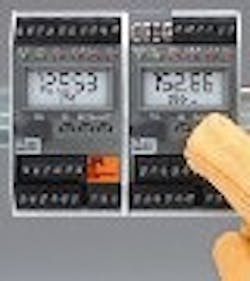Universal alarm trip consolidates functions
MANAGING THE CLOSED-LOOP control of sensitive processes is tricky business. To do it (and to keep the batch, or whatever is being brewed, mixed or cooked within spec) conditions across the process must be monitored closely--usually via a variety of sensing and monitoring technologies. Trickier still is the job of managing all those inputs from this gang of sensors and critical transmitters to create an efficient and accurate distributed control system. Back in the day, to field such sophisticated control automation a complex battery of dedicated single-function relays was often required just to get all the on/off, alarm and condition signals headed in the right direction, regardless of whether or not they were off to prompt process change or warn operators of impending doom.Basically, the more sophisticated the process, the more gear it took to run it right. Not only were control cabinets getting incredibly crowded, having to buy all those devices was getting to be a pretty darned expensive proposition to boot. Fortunately for all of us, time and technology march on and competitive forces among control system and component manufacturers have prompted new waves of technical refinement to simplify and consolidate functionality. And as straightforward as they might be functionality-wise, the same has been true for limit alarm trips. Case in point is a universal SPA2 programmable current/voltage and RTD/thermocouple limit alarm trip from Moore Industries that delivers on/off control, and can warn of trouble by providing as many as four relay outputs when a monitored process signal falls outside a user-selectable high or low limit. In other words, the device is appropriate to activate warning lights, annunciators, and pump, motor or other shutdown systems.According to Steve Todd of Moore Industries, The SPA2 is really six universal instruments in one. Available models accept input signals from transmitters, temperature sensors, resistance and potentiometer devices and virtually all direct millivolt sources. Todd says that means theres no need to specify and stock an array of single-function trips. Just standardize on one and youre all set.Designed to industry standards, the devices are CE Conformant (EMC Directive 89/336/EEC En 61326; Low Voltage Directive 73/23/EEC EN 61010) and provide two or four independent and individually configurable alarm relay outputs. Using integrated controls or the companys free Windows-based PC configuration software, each individual alarm trip relay can be programmed as either a high/low limit process alarm, a rate-of-change alarm, an input fault alarm or a self diagnostic alarm.When an alarm trip and transmitter are needed at the same location, says Todd, the SPA2 can be equipped with an auxiliary analog output to provide a single solution, and reduce costs and installation time. The device offers most all the things users should expect these days: a compact footprint, DIN-rail mounting and a RFI-resistant metal housing. Perhaps unexpected is the units 20-bit input resolution and large five-digit process and status readout for viewing process variables and output. Users can toggle between the two in selectable engineering units as well, says Todd.The company claims operating parameters can be programmed quickly via its front panel pushbuttons or through what it terms Intelligent configuration software. Regardless, it offers a bunch of versatile programmable functions including security password protection, input type and measurement range (zero and full-scale values), input and output trimming, failsafe or non-failsafe, and normally opened or normally closed alarm relays, alarm deadband (0100%) and alarm time delay, differential or averaging of RTD inputs, analog signal output range (through the software only) and analog signal output damping (030 sec.).Of particular note is the users ability to create 128-point linearization curves. The ability to plot a custom linearization curve is beneficial when non-linear input signals must be converted to linear output representations, explains Todd. Typical applications include monitoring a non-linear transducer, the level of odd-shaped tanks and flowmeter linearization.Helpful to any process control engineer is the SPA2s total sensor diagnostics for RTD inputs (available on the model that handles temperature sensor inputs). The SPA2 can perform continuous sensor diagnostics, says Todd. This industry-first and patented Moore Industries feature saves time and money by letting users know when a problem occurs, and its type and location. If the RTD input breaks, users can decide whether or not to trip one or more alarms to indicate trouble. A plain-English error message on the display, as well as on the PC configuration software indicates exactly which RTD wire has broken. With specific error messages like that available, diagnosing a problem is straightforwardnot bad for a simple alarm trip.


